Imagine stepping into your kitchen and finding a vibrant, aromatic oasis that not only delights your senses but also enriches your culinary creations. Whether you’re just starting to dabble in the world of plants or you’re a seasoned green thumb, “DIY Indoor Herb Garden Ideas” is your gateway to transforming any indoor space into a lush, flavorful sanctuary.
This guide offers a treasure trove of creative and practical designs to suit every lifestyle and living situation. From maximizing tiny windowsills to crafting stylish vertical gardens, you’ll discover that growing your own herbs is not only achievable but immensely rewarding.
Beyond the beauty and satisfaction of nurturing your own greenery, an indoor herb garden provides endless practical benefits—from fresh ingredients at your fingertips to the gentle purification of your home’s air. You’ll feel empowered and inspired as you explore ideas that promise to turn your indoor gardening dreams into a flourishing reality.
Choose Compact Herb Varieties
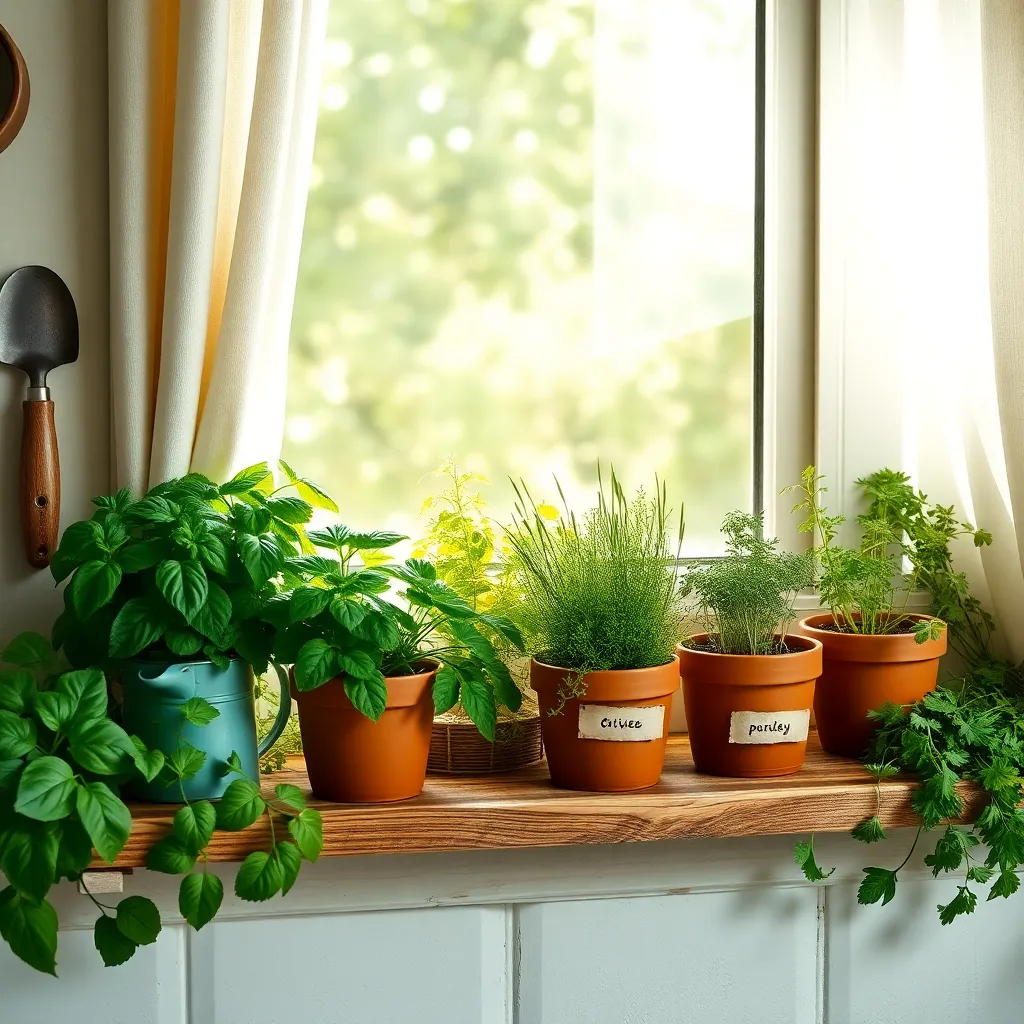
Choosing compact herb varieties is essential for an indoor herb garden, as they take up less space and thrive in contained environments. Consider varieties like ‘Spicy Globe’ basil, ‘Fernleaf’ dill, and ‘Corsican’ mint, which are specifically bred to grow smaller yet remain flavorful.
Compact herbs generally require less soil and can be comfortably grown in small pots. Use a high-quality potting mix that drains well, and ensure that each container has adequate drainage holes to prevent waterlogging.
Good lighting is crucial for the success of compact herbs indoors. Position your herbs near a sunny window or use a grow light for about 12 to 16 hours a day to mimic natural sunlight and encourage healthy growth.
Watering needs can vary depending on the specific herb, but a general rule is to water once the top inch of soil feels dry. Be cautious not to overwater, as this can lead to root rot, particularly in smaller pots where moisture accumulates quickly.
Use Recycled Containers Creatively
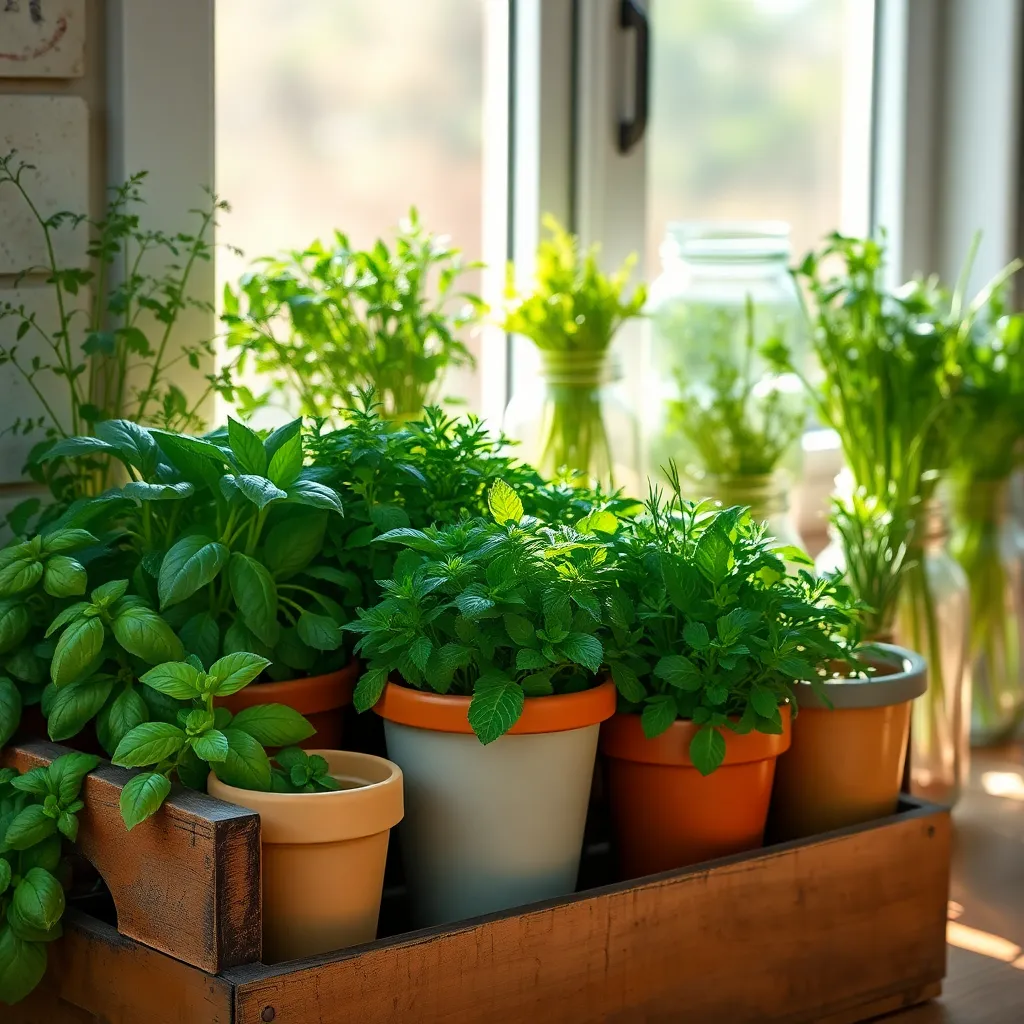
Transform old containers into charming planters to create a sustainable and personalized herb garden. Recycled containers like tin cans, glass jars, and even broken teapots can add a unique touch to your indoor garden while being environmentally friendly.
Ensure each container has adequate drainage by drilling holes at the bottom, which is essential to prevent root rot. If drilling isn’t possible, add a layer of small pebbles to the bottom of the container to facilitate drainage.
When selecting soil, opt for a high-quality potting mix that retains moisture yet drains well, ensuring your herbs thrive. Mixing in a handful of perlite or coarse sand can improve drainage further, especially in containers with limited holes.
To accommodate various herbs, choose containers of different sizes and depths, providing enough room for root growth. For example, basil and mint require larger and deeper containers, whereas chives and thyme can thrive in shallower ones.
Maintain a consistent watering schedule, typically every 3-4 days, depending on your home’s humidity and temperature. Always check the soil moisture with your finger; if the top inch feels dry, it’s time to water your plants.
For an added touch, label each container with painted rocks or wooden stakes to easily identify your herbs. This not only keeps your garden organized but also adds a decorative element to your indoor space.
Ensure Proper Drainage Holes
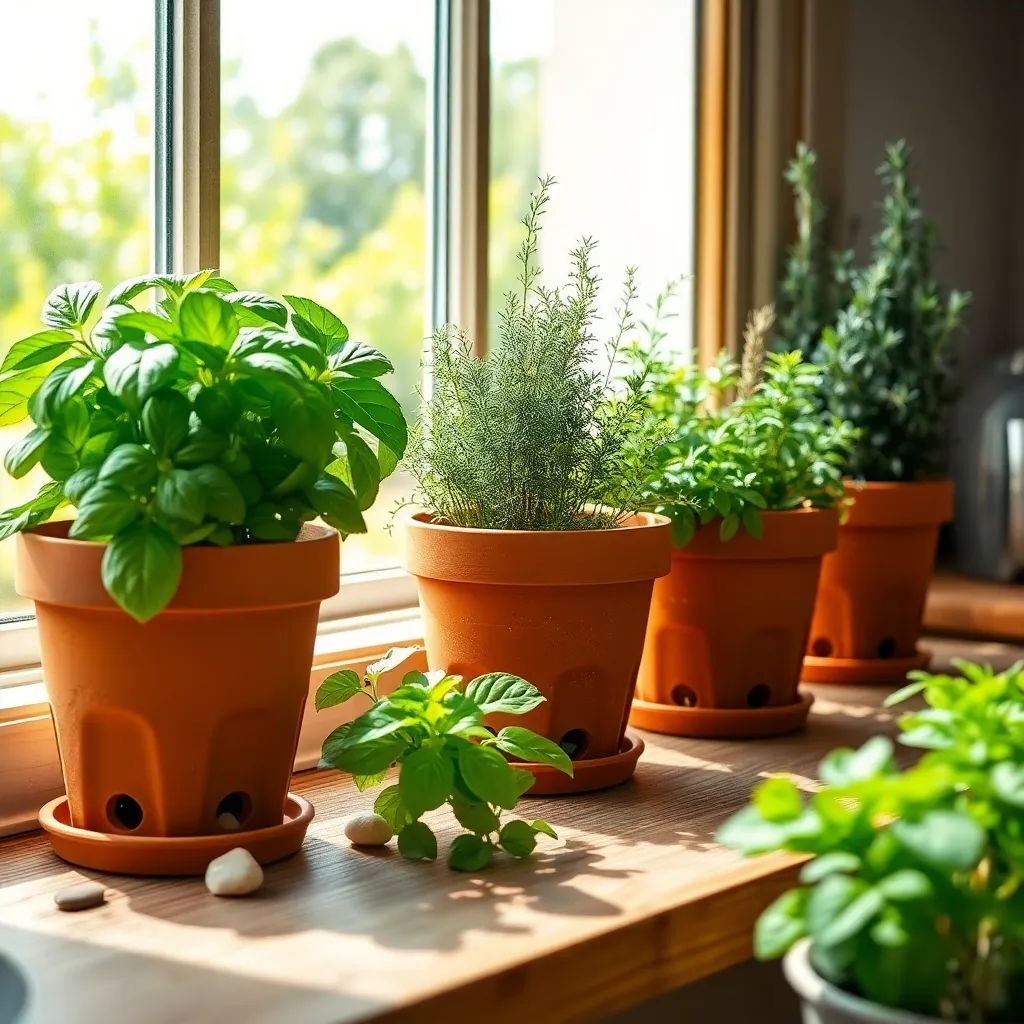
Proper drainage is crucial when using recycled containers for your indoor herb garden. Without adequate drainage holes, excess water can accumulate, leading to root rot and other issues. To ensure your herbs thrive, check if your chosen container already has drainage holes. If not, you can easily create them using a drill or a hammer and nail, making sure they’re evenly spaced.
For beginners, it’s essential to understand that different herbs have varying moisture needs. Generally, most herbs prefer soil that is consistently moist but never waterlogged, which is why proper drainage is vital. A good rule of thumb is to water your herbs only when the top inch of soil feels dry to the touch. Use a well-draining soil mix, such as a combination of potting soil and perlite, to further enhance drainage.
Advanced gardeners might consider adding a layer of small stones or gravel at the bottom of each container. This helps facilitate even better drainage, particularly for herbs like rosemary and thyme that are more sensitive to overwatering. Additionally, elevating your pots slightly using pot feet or small blocks can prevent water from pooling at the base, ensuring your plants’ roots stay healthy and happy.
Remember, monitoring your plant’s drainage needs isn’t a one-time task. Regularly check the drainage holes to ensure they remain unobstructed by soil or roots. This simple practice can make a significant difference in the health and productivity of your indoor herb garden. By ensuring proper drainage, you’re setting up your herbs for success, allowing them to grow robustly and flavorfully.
Position Near Sunlit Windows
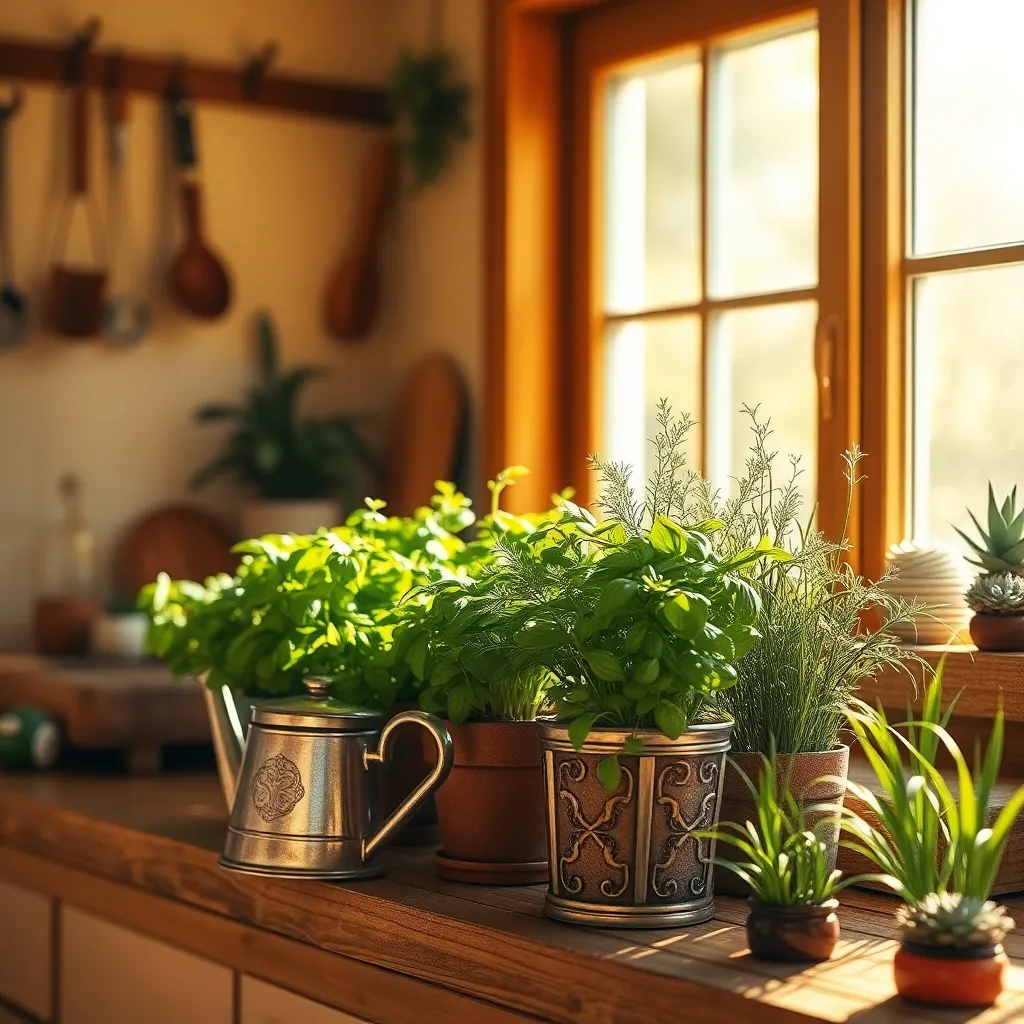
To maximize the growth of your indoor herb garden, strategically positioning your plants near sunlit windows is essential. Most herbs thrive with at least six hours of sunlight each day, so choose a south or west-facing window for the best results.
It’s important to rotate your plants regularly to ensure even growth. This simple act allows all sides of the plant to receive adequate sunlight, preventing them from leaning towards the light source.
For herbs that prefer lower light conditions, such as mint or parsley, an east-facing window can provide the perfect amount of indirect sunlight. However, if natural light is limited, consider supplementing with grow lights to maintain healthy growth.
Advanced gardeners might experiment with reflective surfaces, like mirrors or aluminum foil, to amplify the available light. This technique can help boost the light exposure for herbs situated in less-than-ideal locations.
Rotate Plants for Even Growth
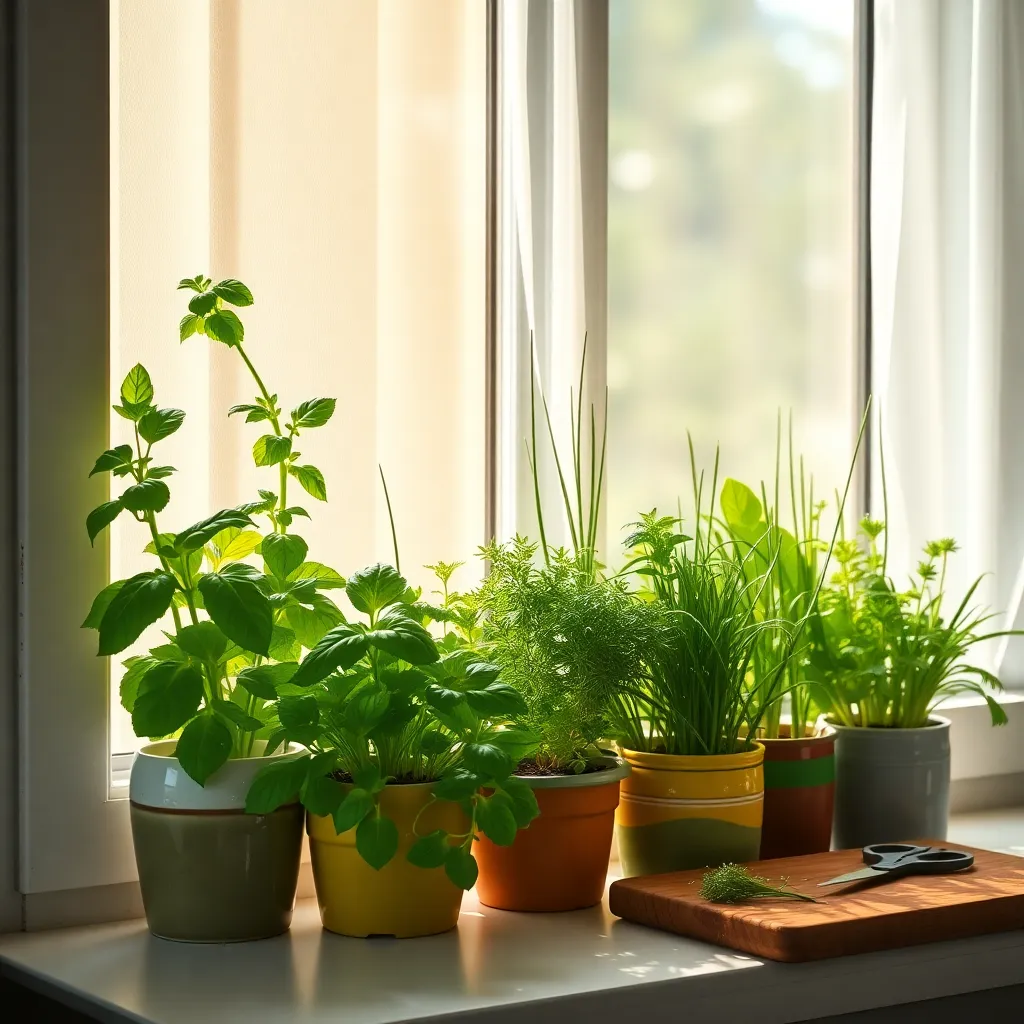
Rotating your herb plants regularly ensures that all sides receive equal exposure to sunlight, promoting even growth. Especially for indoor gardens near windows, turning your pots every week helps plants grow straight and prevents them from leaning toward the light source.
Begin by observing which side of your plant is growing more vigorously—this side likely receives more light. Rotate the pot 180 degrees each time you water, ensuring all sides get their fair share of sunlight over time.
For those with limited window space, consider using a small rotating platform or lazy Susan to make the process easier. This simple tool allows you to effortlessly turn your pots, ensuring that no part of your herb garden is left in the shade.
Advanced gardeners can use a light meter to measure the intensity of light on each side of their plants, adjusting the rotation schedule accordingly. Adjust the frequency of rotation based on the growth rate and size of your plants; faster-growing herbs might benefit from more frequent turns.
Conclusion: Growing Success with These Plants
As we’ve explored in ‘DIY Indoor Herb Garden Ideas,’ nurturing your relationship can be likened to cultivating a thriving herb garden. First, we discussed *communication*—just as herbs need sunlight, relationships thrive on open dialogue. Next, *patience* is crucial, as both plants and partnerships require time to grow. Third, we highlighted *commitment*, similar to the daily care your garden demands. Fourth, we touched on *flexibility*, reminding us to adapt to changing conditions, whether in soil or relationship dynamics. Lastly, *shared goals* are vital, much like planning your garden layout together for the best harvest.
Take immediate action today by choosing one relationship concept to focus on, such as enhancing your communication skills or establishing a shared goal with your partner. This small step can lead to a significant positive shift.
Don’t forget to save or bookmark this article for future reference, as these insights are tools you’ll want to revisit. Remember, just like a flourishing herb garden, a successful relationship is built with care, attention, and continual learning. Embrace these concepts, and watch your relationship blossom into a resilient, vibrant partnership that stands the test of time.

